Abstract
Gerhardt, Philipp (The University of Michigan, Ann Arbor), and D. M. Gallup. Dialysis flask for concentrated culture of microorganisms. J. Bacteriol 86:919–929. 1963.—A twin-chambered dialysis flask was designed with a supported membrane clamped between a reservoir of medium in the bottom and a small volume of culture above, the unit being mounted on a shaking machine to provide aeration and agitation. The performance of different dialysis membranes and membrane filters was compared in glucose-diffusion and bacterial-culture tests. Some of the variables in dialysis culture were assessed and the growth response was characterized, with Serratia marcescens as the test organism. The general usefulness and concentrating effect of dialysis culture were demonstrated in trials with 16 representative types of microorganisms. Dialysis culture was shown to be especially suitable for producing dense populations of cells or their macromolecular products in an environment free from complex medium constituents, for removing toxic products that limit growth or fermentation, and for supplying oxygen by diffusion without the damage from usual aeration procedures.
Full text
PDF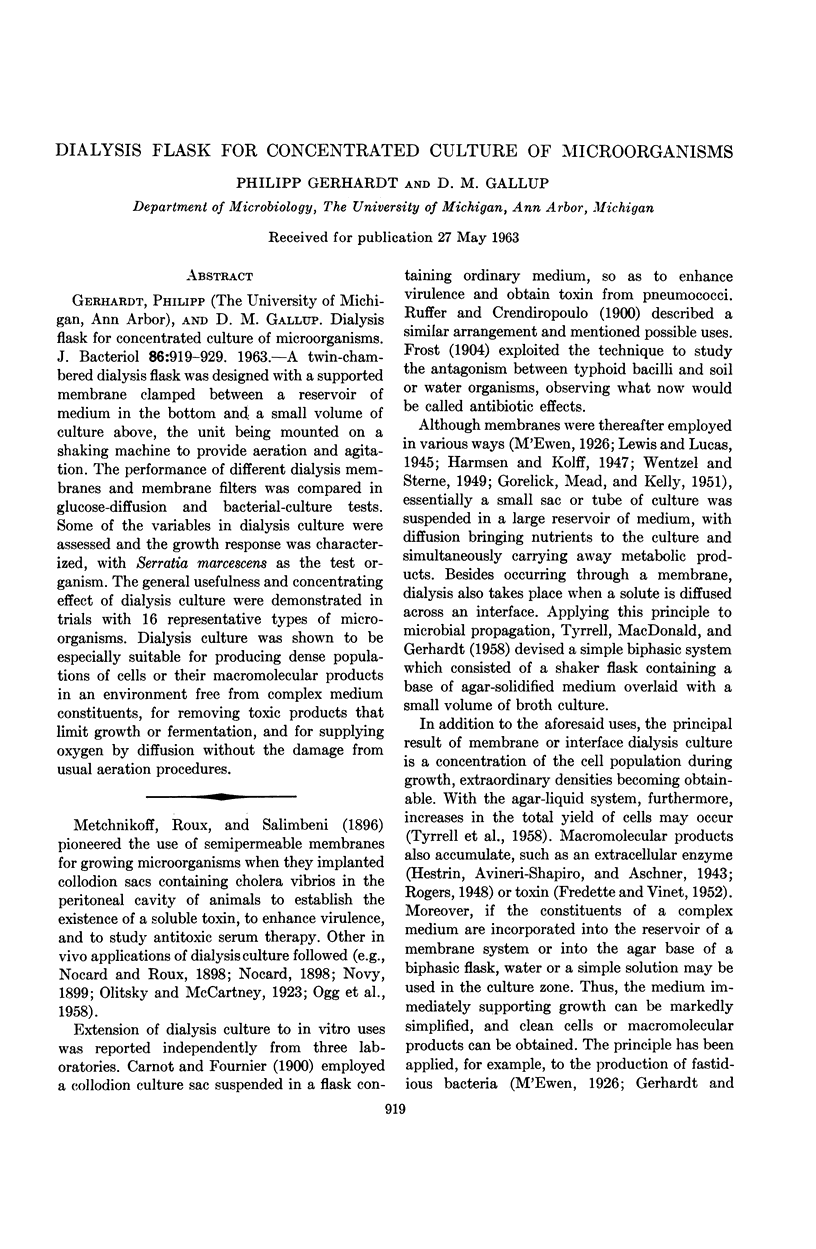

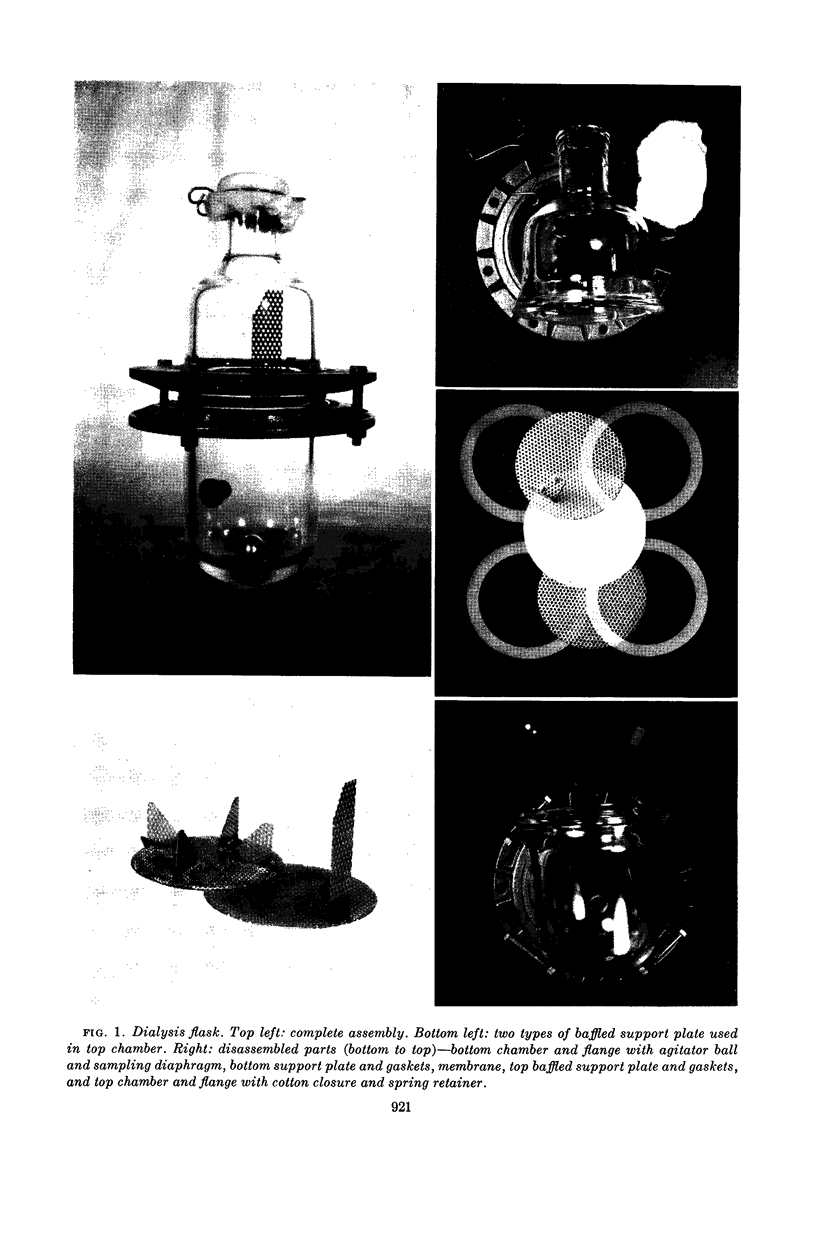



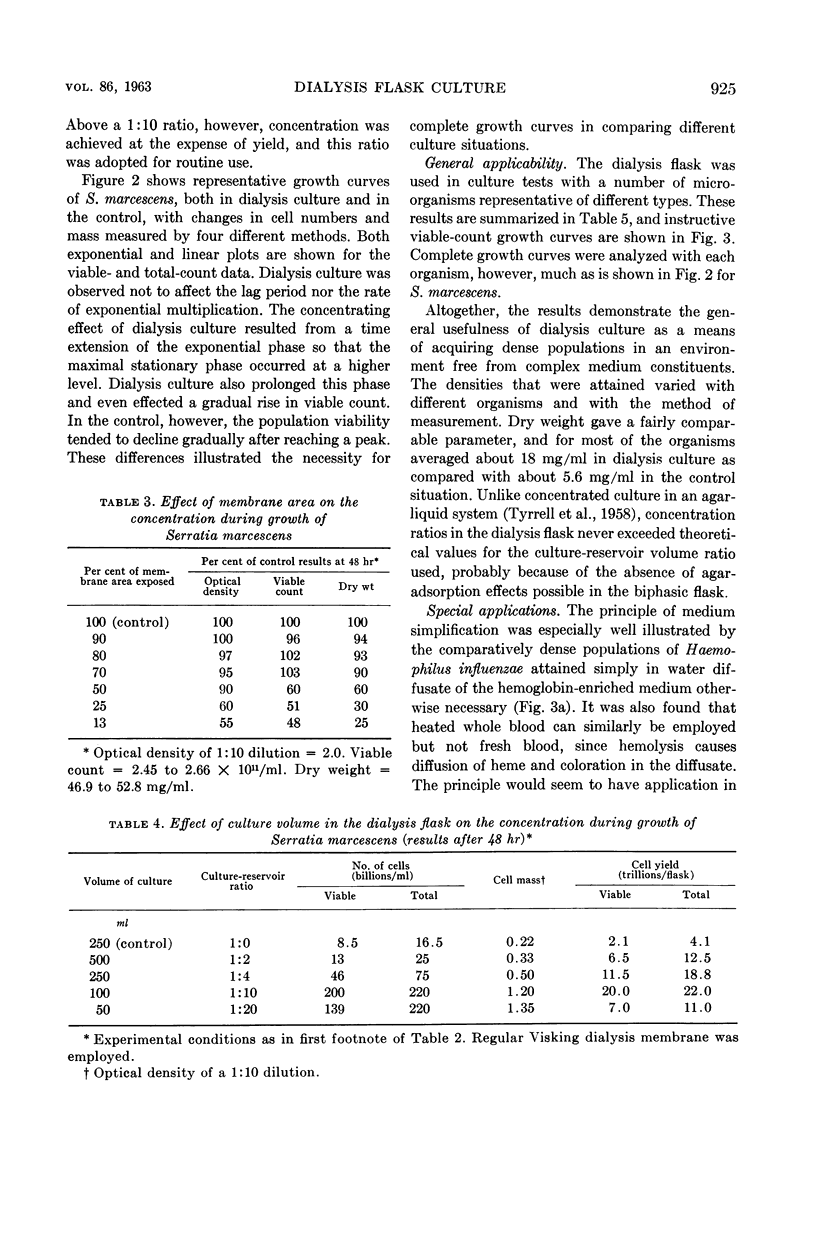
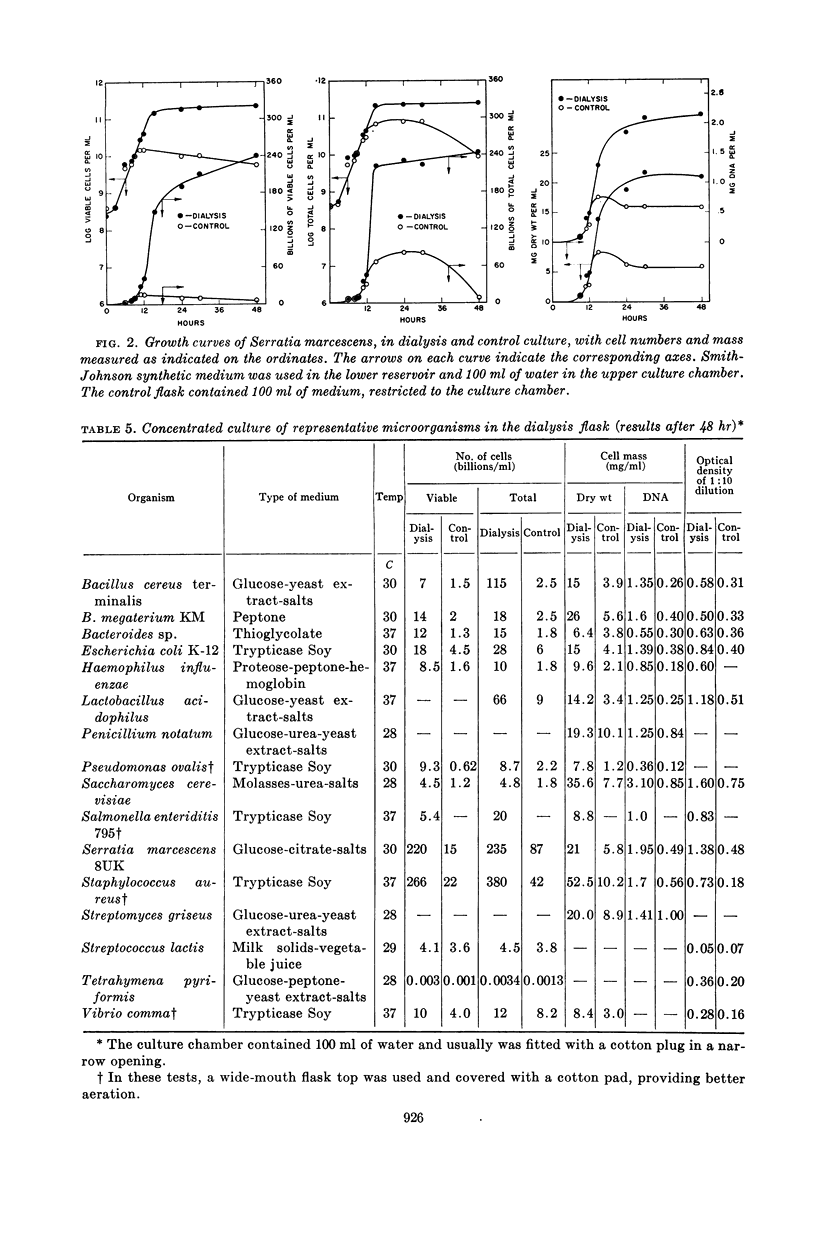
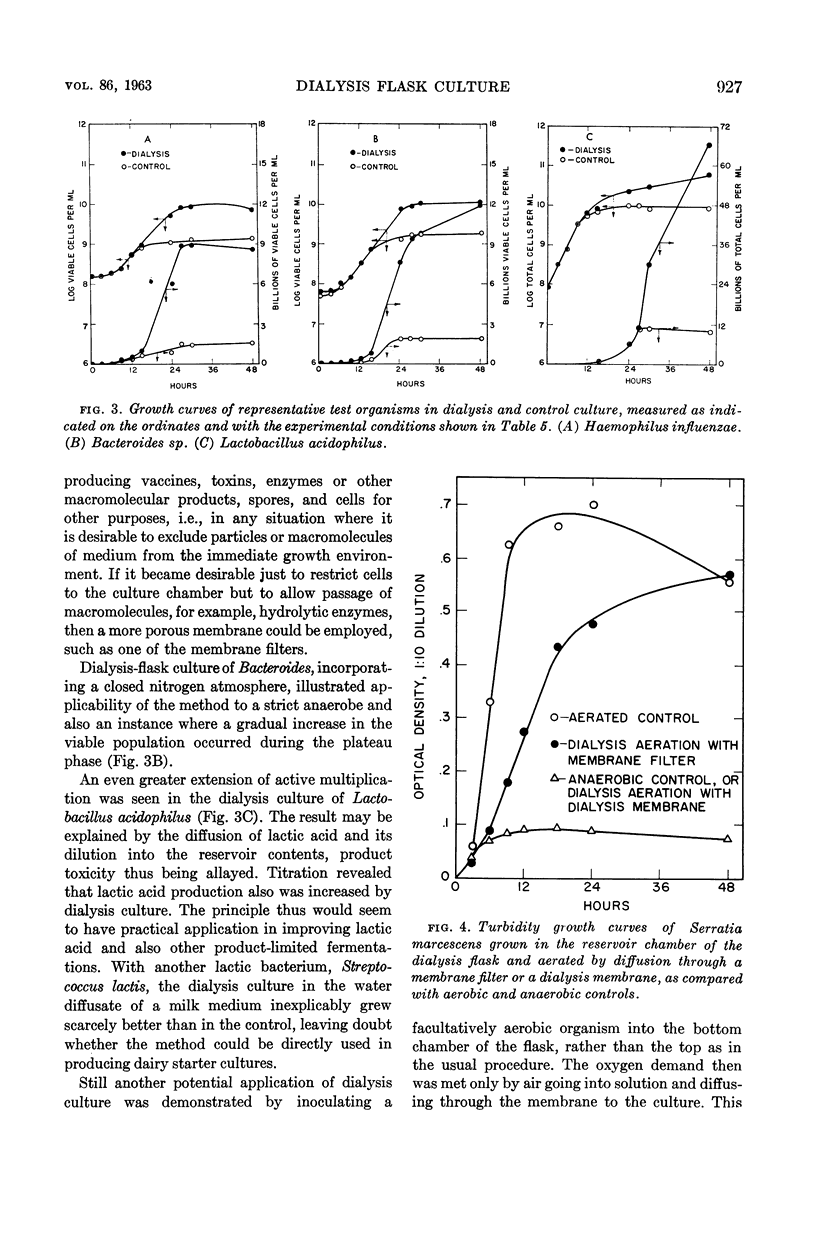


Images in this article
Selected References
These references are in PubMed. This may not be the complete list of references from this article.
- BARRON A. L., REED G. B. Clostridium botulinum type E toxin and toxoid. Can J Microbiol. 1954 Oct;1(2):108–117. doi: 10.1139/m55-014. [DOI] [PubMed] [Google Scholar]
- Eagle H. THE SUSTAINED GROWTH OF HUMAN AND ANIMAL CELLS IN A PROTEIN-FREE ENVIRONMENT. Proc Natl Acad Sci U S A. 1960 Apr;46(4):427–432. doi: 10.1073/pnas.46.4.427. [DOI] [PMC free article] [PubMed] [Google Scholar]
- FREDETTE V., VINET G. Production en sac de cellophane de toxines tétaniques renfermant au moins 600,000 doses mortelles (cobaye) par millilitre. Can J Med Sci. 1952 Apr;30(2):155–156. [PubMed] [Google Scholar]
- GERHARDT P., HEDEN C. G. Concentrated culture of gonococci in clear liquid medium. Proc Soc Exp Biol Med. 1960 Oct;105:49–51. doi: 10.3181/00379727-105-26005. [DOI] [PubMed] [Google Scholar]
- GORELICK A. N., MEAD D. D., KELLY E. H. The growth of bacteria in a charcoal-cellophane system. J Bacteriol. 1951 Apr;61(4):507–513. doi: 10.1128/jb.61.4.507-513.1951. [DOI] [PMC free article] [PubMed] [Google Scholar]
- Gallup D. M., Gerhardt P. Dialysis Fermentor Systems for Concentrated Culture of Microorganisms. Appl Microbiol. 1963 Nov;11(6):506–512. doi: 10.1128/am.11.6.506-512.1963. [DOI] [PMC free article] [PubMed] [Google Scholar]
- Harmsen G. W., Kolff W. J. Cultivation of Microorganisms With the Aid of Cellophane Membranes. Science. 1947 May 30;105(2735):582–583. doi: 10.1126/science.105.2735.582-a. [DOI] [PubMed] [Google Scholar]
- Hestrin S., Avineri-Shapiro S., Aschner M. The enzymic production of levan. Biochem J. 1943 Oct;37(4):450–456. doi: 10.1042/bj0370450. [DOI] [PMC free article] [PubMed] [Google Scholar]
- Lewis R. W., Lucas E. H. APPARATUS FOR GROWING MICROORGANISMS ON A FLOWING MEDIUM. Science. 1945 Apr 6;101(2623):364–365. doi: 10.1126/science.101.2623.364-a. [DOI] [PubMed] [Google Scholar]
- NURMIKKO V. Microbiological determination of vitamins and amino acids produced by microorganisms, using the dialysis cell. Appl Microbiol. 1957 May;5(3):160–165. doi: 10.1128/am.5.3.160-165.1957. [DOI] [PMC free article] [PubMed] [Google Scholar]
- OGG J. E., FRIEDMAN S. B., ANDREWS A. W., SURGALLA M. J. Factors influencing the loss of virulence in Pasteurella pestis. J Bacteriol. 1958 Aug;76(2):185–191. doi: 10.1128/jb.76.2.185-191.1958. [DOI] [PMC free article] [PubMed] [Google Scholar]
- Ritter H. A METHOD FOR CULTIVATING HEMOPHILUS INFLUENZAE. J Bacteriol. 1949 Apr;57(4):474–475. [PMC free article] [PubMed] [Google Scholar]
- Rogers H. J. The complexity of the hyaluronidases produced by micro-organisms. Biochem J. 1948;42(4):633–640. doi: 10.1042/bj0420633. [DOI] [PMC free article] [PubMed] [Google Scholar]
- SCHNEIDER M. D., GRECZ N., ANELLIS A. Sporulation of Clostridium botulinum types A, B, and E, Clostridium perfringens, and putrefactive anaerobe 3679 in dialysis sacs. J Bacteriol. 1963 Jan;85:126–133. doi: 10.1128/jb.85.1.126-133.1963. [DOI] [PMC free article] [PubMed] [Google Scholar]
- SMITH C. G., JOHNSON M. J. Aeration requirements for the growth of aerobic microorganisms. J Bacteriol. 1954 Sep;68(3):346–350. doi: 10.1128/jb.68.3.346-350.1954. [DOI] [PMC free article] [PubMed] [Google Scholar]
- TYRRELL E. A., MACDONALD R. E., GERHARDT P. Biphasic system for growing bacteria in concentrated culture. J Bacteriol. 1958 Jan;75(1):1–4. doi: 10.1128/jb.75.1.1-4.1958. [DOI] [PMC free article] [PubMed] [Google Scholar]
- Wentzel L. M., Sterne M. A Simple Double-Surface Dialyzing Membrane. Science. 1949 Sep 9;110(2854):259–259. doi: 10.1126/science.110.2854.259. [DOI] [PubMed] [Google Scholar]



